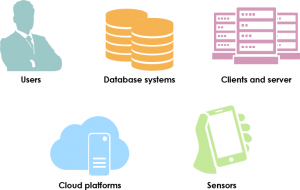رویکرد مورد استفاده نوعی تکنیک برای شناسایی اهداف تجاری یک سیستم است. شناسایی موارد استفاده به تعریف دامنه سیستم کمک میکند و اطمینان حاصل میکند که الزامات شناسایی شده با ارزشها، نیازها و استراتژیهای تجاری همراستا خواهند بود.
بازیگران در تحلیل موارد استفاده چه کسانی هستند؟
یک بازیگر نقش کاربر یا هر سیستم دیگری که با سیستم در حال توسعه تعامل دارد را مشخص میکند. این ممکن است نمایانگر نقشی باشد که توسط کاربران انسانی، سختافزارهای خارجی یا دیگر اصول انجام میشود. بازیگران همیشه خارج از سیستم هستند و بهطور مستقیم با موارد استفاده تعامل دارند، با شروع آنها، ارائه ورودی به آنها و/یا دریافت خروجی از آنها. در حالی که یک نمونه فیزیکی واحد ممکن است نقش چندین بازیگر مختلف را ایفا کند، بازیگران لزوماً نمایانگر یک موجودیت فیزیکی خاص نیستند، به عنوان مثال، تایمر که ارسال هشدارهای ایمیلی را فعال میکند.
شناسایی موارد استفاده – ویژگیهای بازیگر در تحلیل موارد استفاده
به سادگی برداشتهای اعضای تیم از ذینفعان یا کاربران هدف را شمارش کنید و در طول بحث به توافق رسیدن آسانتر خواهد بود.
- بازیگران در خارج از سیستم قرار دارند و به بخش خاصی از سیستم تعلق ندارند، بنابراین نیازی به «ساختن» «بازیگران» نداریم؛
- فقط کسانی که میتوانند از سیستم استفاده کنند، با سیستم تعامل داشته باشند و اطلاعات را با سیستم مبادله کنند، بازیگران سیستم هستند؛
- بازیگران موارد استفاده را شروع و در آنها شرکت خواهند کرد، بنابراین پیدا کردن بازیگران میتواند ما را در شناسایی موارد استفاده راهنمایی کند؛
- اگرچه نیازی به «توسعه بازیگران» نداریم، اما باید به رابطها توجه کنیم. سیستم باید رابطی را برای استفاده بازیگران در نظر بگیرد (تجربه کاربری / GUI)، یا سیستم باید دادهها را از طریق رابط ارائه شده توسط بازیگران دریافت کند.
بازیگران چه کسانی هستند؟ سوالات زیر را بپرسید:
- چه کسی از این سیستم استفاده خواهد کرد؟
- چه کسی این سیستم را نصب خواهد کرد؟
- چه کسی این سیستم را راهاندازی خواهد کرد؟
- چه کسی این سیستم را نگهداری خواهد کرد؟
- چه کسی این سیستم را خاموش خواهد کرد؟
- کدام سیستمهای دیگر از این سیستم استفاده خواهند کرد؟
- چه کسی اطلاعات را از این سیستم دریافت خواهد کرد؟
- چه کسی اطلاعات را به این سیستم ارائه خواهد داد؟
- وقتی زمان تعیین شده فرا میرسد، آیا چیزی بهطور خودکار اتفاق خواهد افتاد؟
- کدام سیستمها با این سیستم شبکه خواهند شد؟
- آیا دستگاههای سختافزاری به این سیستم متصل هستند؟
- کدام پایگاههای داده با این سیستم شبکه خواهند شد؟
- چه کسی در شرکت از این سیستم استفاده خواهد کرد؟\
- چه کسی از این سیستم خارج از شرکت استفاده خواهد کرد؟
- وقتی یک زمان یا رویداد خاص رخ میدهد، آیا این سیستم نیاز دارد بهطور خودکار به چه کسی یا سیستمهای دیگر اطلاع دهد؟
انواع بازیگر
بسیاری از تحلیلگران در فرآیند ترسیم نمودار موارد استفاده، بازیگران کلیدی را نادیده میگیرند زیرا فقط بازیگران انسانی را شناسایی میکنند. طبقهبندی بازیگران موارد استفاده به این روش به تحلیلگران کمک میکند تا اطمینان حاصل کنند که هیچ بازیگر کلیدی را در نمودار موارد استفاده نادیده نمیگیرند.
روش دیگری برای طبقهبندی شرکتکنندگان وجود دارد. آنها میتوانند باشند:
- انسانها
- سیستم / نرمافزار
- سختافزار
- تایمر / ساعت

فهرستی از سوالات برای شناسایی موارد استفاده
- شرکتکنندگان چه نوع عملکردهایی را از این سیستم میخواهند؟
- آیا این سیستم اطلاعات را ذخیره میکند؟ کدام شرکتکنندگان این اطلاعات را ایجاد، خواندن، بهروزرسانی و حذف خواهند کرد؟
- آیا سیستم نیاز دارد به شرکتکنندگان اطلاع دهد وقتی وضعیت داخلی سیستم تغییر میکند؟
- آیا رویدادهای خارجی وجود دارد که سیستم نیاز به دانستن آنها داشته باشد؟ وقتی این رویداد خارجی رخ میدهد، کدام بازیگر به سیستم اطلاع خواهد داد؟
- آیا این سیستم نیاز دارد بهطور منظم عملیات خاصی را انجام دهد؟
- وقتی برخی از رویدادهای مهم خارجی رخ میدهند، آیا سیستم نیاز دارد بهطور خودکار عملیات خاصی را انجام دهد؟
- آیا نام این مورد استفاده به اندازه کافی واضح است؟ آیا میتوان نتیجه این مورد استفاده را بهطور مستقیم از نام این مورد استفاده قضاوت کرد؟
- آیا این مورد استفاده نتایج متعددی خواهد داشت؟ یا آیا این نتایج در نقاط زمانی مختلف تولید میشوند؟
This post is also available in Deutsch, English, Español, Français, Bahasa Indonesia, 日本語, Polski, Portuguese, Ру́сский, Việt Nam, 简体中文 and 繁體中文.













